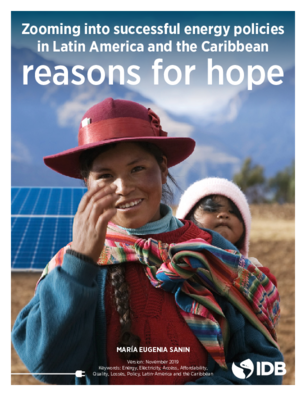Zooming into Successful Energy Policies in Latin America and the Caribbean: Reasons for Hope
Date
Dec 2019
Due to the lack of systematic policy evaluations, identifying successful policies in the Latin American and the Caribbean (LAC) region is a hunting task. Nevertheless, this type of analysis is crucial to inform policymakers in their decision-making process. Herein we contribute to filling this gap by assessing the progress in terms of energy services since the year 2000 and reviewing the policies that have led us to where we are.
We focus on three fundamental dimensions in the definition of energy services: access to electricity and clean fuels for cooking, affordability of those energy services and quality considering both service’s interruptions and energy losses. We find that countries that have improved in all these dimensions simultaneously, catching up with the best performers in the region, are the ones that have implemented integrated policies that are part of a pluriannual plan, implemented in a strong institutional environment.
Aside from macroeconomic differences, successful energy policies have in common the following characteristics: (i) important institutional reforms already in place by the end of the century; (ii) state-led plans that measure performance accounting for most dimensions simultaneously and including mechanisms to enforce preestablished objectives in targeted population; (iii) appropriate financing mechanisms to ensure affordability; and (iv) partnership with private stakeholders when their participation increases efficiency, adoption of innovation and ensure maintenance, either directly or through the involvement of local communities.
Even if the discussion is presented dimension by dimension, two countries appear like having implemented successful integrated policies: Peru and Ecuador. Despite their institutional differences, they have succeeded in increasing access to affordable electricity that is more reliable (with less frequency and duration of interruptions). Additionally, Ecuador has also enhanced efficiency through electricity loss reduction thanks to enforceable performance-based regulation.
Aside from these two countries, other countries have also implemented successful policies that have greatly improved one or two of the dimensions mentioned but fail to tackle all the issues simultaneously. This is the case of El Salvador with access to clean cooking and fuel subsidy reform, for example. Similarly, Nicaragua appears as an example in bridging the gap in access and Brazil, Colombia and more recently Argentina are implementing a mechanism to target demand-side subsidies based on family economic means.
We focus on three fundamental dimensions in the definition of energy services: access to electricity and clean fuels for cooking, affordability of those energy services and quality considering both service’s interruptions and energy losses. We find that countries that have improved in all these dimensions simultaneously, catching up with the best performers in the region, are the ones that have implemented integrated policies that are part of a pluriannual plan, implemented in a strong institutional environment.
Aside from macroeconomic differences, successful energy policies have in common the following characteristics: (i) important institutional reforms already in place by the end of the century; (ii) state-led plans that measure performance accounting for most dimensions simultaneously and including mechanisms to enforce preestablished objectives in targeted population; (iii) appropriate financing mechanisms to ensure affordability; and (iv) partnership with private stakeholders when their participation increases efficiency, adoption of innovation and ensure maintenance, either directly or through the involvement of local communities.
Even if the discussion is presented dimension by dimension, two countries appear like having implemented successful integrated policies: Peru and Ecuador. Despite their institutional differences, they have succeeded in increasing access to affordable electricity that is more reliable (with less frequency and duration of interruptions). Additionally, Ecuador has also enhanced efficiency through electricity loss reduction thanks to enforceable performance-based regulation.
Aside from these two countries, other countries have also implemented successful policies that have greatly improved one or two of the dimensions mentioned but fail to tackle all the issues simultaneously. This is the case of El Salvador with access to clean cooking and fuel subsidy reform, for example. Similarly, Nicaragua appears as an example in bridging the gap in access and Brazil, Colombia and more recently Argentina are implementing a mechanism to target demand-side subsidies based on family economic means.




